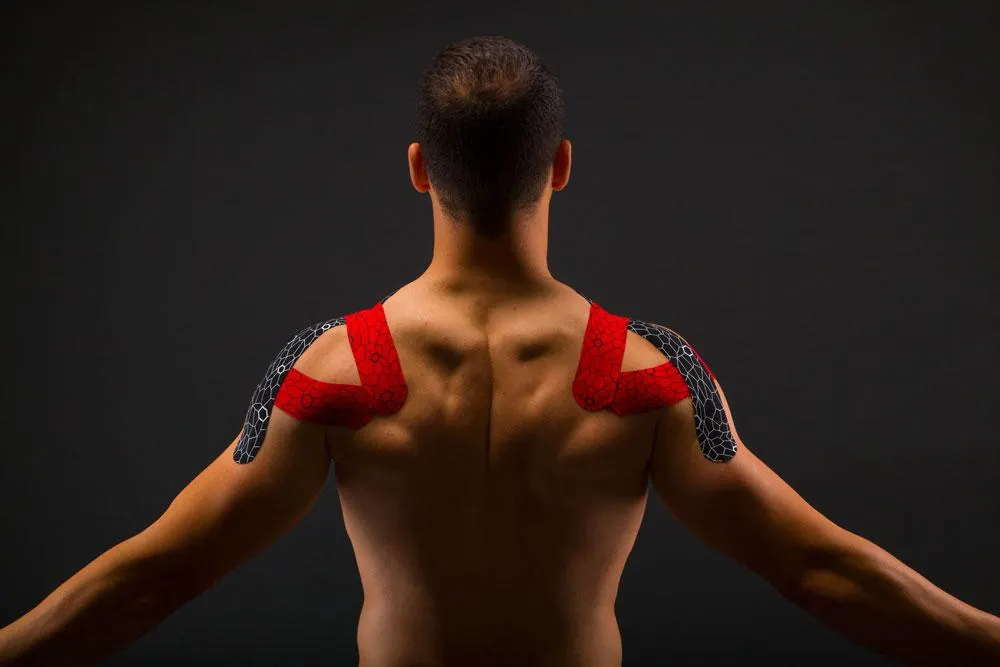Kinesiology Tape Shoulder pain can be debilitating, affecting everyday activities and diminishing quality of life. Whether it’s due to an injury, overuse, or underlying medical conditions, finding relief is crucial. It has gained popularity as a non-invasive, drug-free option for managing shoulder pain effectively.

The Anatomy of the Shoulder
Understanding the Shoulder Structure
The shoulder is a complex joint comprising several bones, muscles, ligaments, and tendons. It consists of three main bones: the humerus (upper arm bone), scapula (shoulder blade), and clavicle (collarbone). These bones, along with associated muscles and soft tissues, work together to provide a wide range of motion to the arm.
Functions of the Shoulder
The primary functions of the shoulder include mobility and stability. It allows for various movements such as flexion, extension, abduction, adduction, and rotation. However, this mobility also makes the shoulder vulnerable to injuries and overuse.
Most Common Injuries Leading to Shoulder Pain
Rotator Cuff Tears
Rotator cuff tears are among the most prevalent shoulder injuries. They occur when the tendons of the rotator cuff muscles become torn or damaged. This can result from sudden trauma, repetitive overhead movements, or degenerative changes in the tendons over time.
Shoulder Impingement Syndrome
Shoulder impingement syndrome occurs when the tendons of the rotator cuff and the bursa (fluid-filled sac) become compressed or pinched between the bones of the shoulder. This can cause inflammation, pain, and limited range of motion, especially when raising the arm overhead.
Bursitis
Bursitis is the inflammation of the bursa, which cushions the bones, tendons, and muscles near joints. In the shoulder, bursitis often occurs in the subacromial bursa, leading to pain, swelling, and discomfort, particularly with overhead activities.
How Kinesiology Tape Works
It works by providing support to muscles and joints while allowing for a full range of motion. It works on the principle of proprioception, which involves the body’s awareness of its position and movement in space. By gently lifting the skin and creating space between the layers, It can reduce pressure on the underlying tissues, alleviate pain, and promote healing.
Mechanism of Action
The elastic properties of kinesiology tape allow it to stretch and recoil, mimicking the flexibility of human skin and muscles. This elasticity provides dynamic support to the affected area, enhancing blood circulation and lymphatic drainage, which aids in reducing inflammation and promoting tissue repair.
Benefits of Using Kinesiology Tape for Shoulder Pain
- Pain Relief: Kinesiology tape can help alleviate shoulder pain by reducing pressure on sensitive tissues and providing support to weakened or injured muscles.
- Improved Range of Motion: By supporting the shoulder joint and muscles, It can enhance mobility and flexibility, allowing for smoother movements and reducing the risk of further injury.
- Enhanced Healing: The increased circulation and lymphatic drainage facilitated by kinesiology tape can accelerate the healing process, promoting tissue repair and reducing recovery time.
How to Apply Kinesiology Tape for Shoulder Pain
Preparation
Before applying kinesiology tape, ensure that the skin is clean, dry, and free from any lotions or oils. Trim any excess hair if necessary to ensure proper adhesion. It’s also helpful to stretch and warm up the muscles before taping to enhance blood flow and flexibility.
Application Technique
Start by identifying the specific area of pain or instability in the shoulder. Cut the kinesiology tape into the desired shape and size, rounding the edges to prevent premature peeling. Apply the tape with gentle tension, overlapping the ends slightly to create a stable anchor. Avoid applying excessive tension, as this can restrict circulation and cause discomfort.
Tips for Using Kinesiology Tape Effectively
- Proper Placement: Ensure that the tape is applied correctly, following the natural contours of the shoulder and surrounding muscles.
- Monitor Skin Reaction: Check the skin regularly for any signs of irritation or allergic reaction. If redness, itching, or discomfort occurs, remove the tape immediately and consult a healthcare professional.
- Stay Active: Kinesiology tape is designed to be worn during physical activity, so don’t hesitate to engage in gentle exercises or movements to maximize its effectiveness.
- Replace Regularly: Depending on the type of tape and level of activity, kinesiology tape may need to be replaced every few days to maintain optimal adhesion and support.
Precautions and Contraindications
While kinesiology tape is generally safe for most people, there are certain precautions to consider:
- Avoid applying tape over open wounds, bruises, or irritated skin.
- Discontinue use if excessive redness, swelling, or pain occurs.
- Consult a healthcare professional before using kinesiology tape if you have any underlying medical conditions or concerns.
When to Seek Medical Help
If shoulder pain persists or worsens despite using kinesiology tape and other conservative measures, it’s essential to seek medical attention. A healthcare provider can conduct a thorough evaluation, diagnose any underlying issues, and recommend appropriate treatment options, which may include physical therapy, medication, or surgery.
Conclusion
Kinesiology tape offers a safe, non-invasive option for managing shoulder pain and promoting recovery. By understanding the anatomy of the shoulder, common injuries, and proper application techniques, individuals can effectively use kinesiology tape as part of their pain management strategy. However, it’s essential to use caution and seek medical advice if needed to ensure safe and effective use.
FAQs
1. Is kinesiology tape waterproof?
While some varieties of kinesiology tape are water-resistant, they may not be entirely waterproof. It’s best to check the product specifications and follow proper application guidelines to ensure durability.
2. Can kinesiology tape be worn overnight?
Yes, It can be worn overnight to provide continuous support and pain relief. However, it’s essential to monitor skin reaction and remove the tape if any discomfort occurs.
3. Can kinesiology tape be used for chronic shoulder pain?
It can be beneficial for managing chronic shoulder pain by providing support to weakened muscles
Also, Read More >>> Solar Panel Kits




